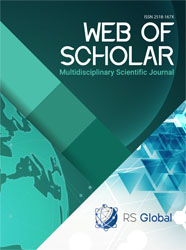PATHOMORPHOLOGICAL CHANGES IN RATS' RETINAL LAYERS AT THE END OF THE TWELFTH WEEK OF EXPERIMENTAL OPIOID INFLUENCE
Abstract
The goal in our work was to study the long-term effects of opioid analgesics in therapeutic doses on the structure of the retinal layers in chronic opioid influence. The goal was achieved by using the microscopic technique of visualizing the retinal layers of the eyeball of the rat. Microstructural preparations were prepared according to the generally accepted method using dyes, hematoxylin, eosin, and azan by the method of Heidenhain.
As a result of the twelve-week experimental opioid effect, we discovered vacuated dystrophy and necrotic changes in the pigment epithelium, with the progression of the phenomenon of microcystoid degeneration of the outer mesh layer, and the increase in changes in the microcirculatory blood flow localized in the inner layers of the retina.
The results of our experimental research in the future will allow us to form a pathomorphological basis, which can be used to perform a comparative characterization of the state of the layers of the retina and its the microcirculatory blood flow in normal range with experimental opioid effects at different terms of acute, subchronic and chronic opioid effects. Using the above information, we will be able to determine the optimal timing for correction in order to reduce and stabilize the pathomorphological manifestations of opioid effects on destructive changes in the layers of the retina and its the microcirculatory blood flow.
Views:
326
Downloads:
178
Copyright (c) 2019 The authors

This work is licensed under a Creative Commons Attribution 4.0 International License.
All articles are published in open-access and licensed under a Creative Commons Attribution 4.0 International License (CC BY 4.0). Hence, authors retain copyright to the content of the articles.
CC BY 4.0 License allows content to be copied, adapted, displayed, distributed, re-published or otherwise re-used for any purpose including for adaptation and commercial use provided the content is attributed.











